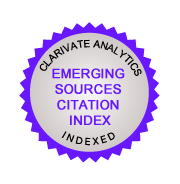Videotutorials and QR codes: ICT resources at Communication Sciences audiovisual labs
DOI:
https://doi.org/10.24310/innoeduca.2017.v3i2.2046Keywords:
Information technology, cooperative learning, blended learning and audiovisual communicationAbstract
The use of ICT (new Information and Communication Technologies) as teaching tools has established itself as an alternative within and outside the classroom that enables the development of significant and collaborative learning processes, and in which there is greater interaction between the student and the object of study. From this premise, a group of assistant and associate professors from the three degrees taught at Faculty of Communication Sciences at the University of Malaga have launched an innovative educational project involving the realization of videotutorials on different equipment present in audiovisual laboratories and of certain general communication skills useful for overcoming subjects framing in the degrees in Journalism, in Advertising and Public Relations and in Audiovisual Communication. After the execution of videoturials by students, under the supervision of the tutor of every single subject, Quick Response Codes (QR codes) were associated to them and located on every equipment and in all the classrooms. This article analyzes the first development process phase of the project, as well as the results of two different learning needs identification surveys sent to Faculty members (students and professors), which reveal on one hand, this type of methodologies implementation demand by the students, and on the other hand, professors positive attitude towards its use.
Downloads
Metrics
Publication Facts
Reviewer profiles N/A
Author statements
Indexed in
-
—
- Academic society
- N/A
- Publisher
- Universidad de Málaga
References
Alexa Web Information Company. (2016). Top sites. Recuperado de http://www.alexa.com/topsites (2016-09-15)
Barkley, E., Cross, K. y Major, C. (2007). Técnicas de aprendizaje colaborativo: Manual para el profesorado universitario. Madrid: Morata.
Bartolome, A. (2002). Universidades en la red. ¿Universidad presencial o virtual? Crítica, LII 896, 34-38.
Bartolome, A. (2008). Entornos de aprendizaje mixto en educación superior. Revista Iberoamericana de Educación a Distancia, 11(1), 15-51.
Bravo, J. (1996). ¿Qué es el vídeo educativo?". Comunicar, nº 6, 100-105.
Brazuelo, F. y Cacheiro, M. (2010). Diseño de páginas webs educativas para teléfonos móviles. Edutec. Revista Electrónica de Tecnología Educativa, 32, 1-14.
Cabero, J., Gisbert, M. (2005). La formación en internet: Guía para el diseño de materiales formativos. Sevilla: Mad.
Cantillo, C., Roura, M. & Sanchez, A. (2012). Tendencias actuales en el uso de dispositivos móviles en educación. La Educ@ción Digital Magazine, 147, 1-20.
Cebrián, M. (1987). El vídeo Educativo. II Congreso de Tecnología Educativa. Madrid: Sociedad Española de Pedagogía.
Espuny, C., Gonzalez, J., Lleixa, M. y Gisbert, M. (2011). Actitudes y expectativas del uso educativo de las redes sociales en los alumnos universitarios. El impacto de las redes sociales en la enseñanza y el aprendizaje. Revista de Universidad y Sociedad del Conocimiento, 1 (8), 171-185.
Fernández, A. (2007). Nuevas metodologías docentes. Instituto de Ciencias de la Educación. Universidad Politécnica de Valencia.
Fundación Telefónica. (2011). Realidad aumentada: una nueva lente para ver el mundo. Madrid: Fundación Telefónica.
Garcia, I., Robles, C. y Correyero, B. (2016). La gestión de equipos de trabajo y productos radiofónicos en las radios universitarias. Revista Latina de Comunicación Social, 71, 696-714.
Greene, K. (2007). Practical holographic video. Massachusetts: Technology review.
Gómez, B. Tapia, F. (2011): Facebook y Tuenti:de plataforma de ocio a herramienta e-learning. Prisma Social: Revista de investigación social, (6) 238-260
Hinojo, F., Aznar, I. & Caceres M. (2009). Percepciones del alumnado sobre el blended learning en la Universidad. Comunicar. Revista Científica de Educomunicación, (33), 165-174.
Jiménez, D. y Marín, G. (2012). Asimilación de contenidos y aprendizaje mediante el uso de videotutoriales. Enseñanza & Teaching: Revista Interuniversitaria de Didáctica (30), 63-79.
Llanos, F. (2008). Videoredada. Recuperado de http://videoredada.blogspot.com.es/2008/02/historia-del-video-para-internet_13.html (2016-09-01)
Mackey, T. & Ho, J. (2008). Exploring the relationships between web usability and students’ perceived learning in web-based multimedia (wbmm) tutorials. Computers & Education, (50), 386-409.
Marse, B. (2012). YouTube: las claves para aprovechar todas sus potencialidades. Barcelona: Profit Editorial.
Marsh, G., Mcfadden, A. y Price, B (2003). Blended instruction: Adapting conventional instruction for large classes. Online Journal of Distance Learning Administration, 4(6).
Mauri, T., Onrubia, J., Coll, C. y Colomina, R. (2005). La calidad de los contenidos educativos reutilizables: Diseño, usabilidad y prácticas de uso. Red. Revista de Educación a Distancia, (50), 1-9.
Mayer, R. (2001). Multimedia learning. New York: Cambridge University Press.
Onrubia, J. (2005). Aprender y enseñar en entornos virtuales: Actividad conjunta, ayuda pedagógica y construcción del conocimiento. Red. Revista de educación a distancia, (2), 1-16.
Polo, V. (2010): Juzgado didáctico: tránsito de la práctica jurídica del aula a la realidad del ejercicio profesional. En de Castro, A. (ed): Innovar para educar: prácticas universitarias exitosas. Barranquilla: Ediciones Uninorte. 60-70.
Santibañez, J. (2010). Aula virtual y presencial en aprendizaje de comunicación audiovisual y educación. Comunicar. Revista científica de educomunicación, (35), 183-191.
Tirado, R; Mendez, J.M. & Aguaded, J.I. (2008). El proyecto Drog@: Comunidades virtuales de aprendizaje. Comunicar, (30), 165-169.
UNESCO. (2013). Directrices de la UNESCO para las políticas de aprendizaje móvil. París: UNESCO.
Zamora, J. & Bello, S. (2011). La videocreatividad, el m-learning y los blogs como herramientas de innovación en el ámbito educativo universitario. Revista Electrónica de Investigación, Docencia y Creatividad, (1), 28-45.
Downloads
Published
How to Cite
Issue
Section
License
All contents published by Innoeduca. International Journal of Technology and Educational Innovation are subject to Creative Commons Attribution-Nocomercial-NoDerivatives 4.0 International License, whose complete text can be consulted at https://creativecommons.org/licenses/by-nc-nd/4.0/legalcode. Thus, copying, distribution, public communication, derivative works and commercial use of content are permitted as of the aforementioned issue provided that the source and the author of the text are cited.
It is the responsibility of the authors to obtain the necessary permits for images that are subject to copyright.

This work is licensed under a Creative Commons Attribution-NonCommercial-NoDerivatives 4.0 International License.












242.png)








